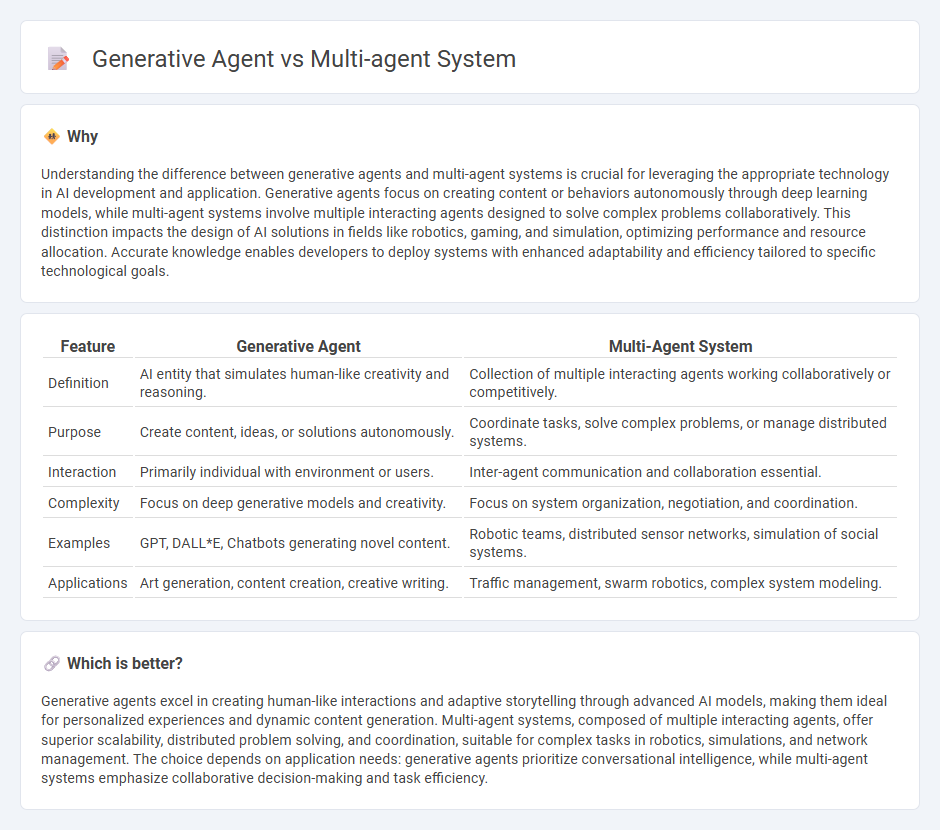
Generative agents use advanced AI models to simulate human-like behaviors and creativity, enabling autonomous content generation and decision-making. Multi-agent systems consist of multiple interacting agents working collaboratively or competitively to solve complex problems and optimize system performance. Explore the distinctions and applications of these technologies to enhance your understanding of modern AI frameworks.
Why it is important
Understanding the difference between generative agents and multi-agent systems is crucial for leveraging the appropriate technology in AI development and application. Generative agents focus on creating content or behaviors autonomously through deep learning models, while multi-agent systems involve multiple interacting agents designed to solve complex problems collaboratively. This distinction impacts the design of AI solutions in fields like robotics, gaming, and simulation, optimizing performance and resource allocation. Accurate knowledge enables developers to deploy systems with enhanced adaptability and efficiency tailored to specific technological goals.
Comparison Table
| Feature | Generative Agent | Multi-Agent System |
|---|---|---|
| Definition | AI entity that simulates human-like creativity and reasoning. | Collection of multiple interacting agents working collaboratively or competitively. |
| Purpose | Create content, ideas, or solutions autonomously. | Coordinate tasks, solve complex problems, or manage distributed systems. |
| Interaction | Primarily individual with environment or users. | Inter-agent communication and collaboration essential. |
| Complexity | Focus on deep generative models and creativity. | Focus on system organization, negotiation, and coordination. |
| Examples | GPT, DALL*E, Chatbots generating novel content. | Robotic teams, distributed sensor networks, simulation of social systems. |
| Applications | Art generation, content creation, creative writing. | Traffic management, swarm robotics, complex system modeling. |
Which is better?
Generative agents excel in creating human-like interactions and adaptive storytelling through advanced AI models, making them ideal for personalized experiences and dynamic content generation. Multi-agent systems, composed of multiple interacting agents, offer superior scalability, distributed problem solving, and coordination, suitable for complex tasks in robotics, simulations, and network management. The choice depends on application needs: generative agents prioritize conversational intelligence, while multi-agent systems emphasize collaborative decision-making and task efficiency.
Connection
Generative agents utilize artificial intelligence models to simulate human-like behaviors by generating novel content or actions, while multi-agent systems consist of multiple interacting agents that collaborate or compete within an environment. The connection lies in using generative agents as components within multi-agent systems to enhance autonomous decision-making and dynamic interaction capabilities. This integration enables complex system behaviors such as adaptive problem-solving, emergent cooperation, and realistic simulation in domains like robotics, gaming, and virtual environments.
Key Terms
Distributed Coordination
Distributed coordination in multi-agent systems involves multiple autonomous agents working collaboratively to achieve shared goals through communication protocols, resource allocation, and conflict resolution. Generative agents, inspired by individual cognitive processes, simulate human-like behaviors and interactions, enabling more adaptive and context-aware coordination in dynamic environments. Explore further to understand how these models differ in scalability, flexibility, and application domains.
Autonomy
Multi-agent systems consist of multiple autonomous agents interacting within an environment to achieve collective goals, emphasizing decentralized decision-making and cooperation. Generative agents possess a higher degree of autonomy by simulating human-like behaviors, creativity, and adaptability through self-learning and dynamic knowledge generation. Explore the fundamental differences in autonomy levels and applications between multi-agent and generative agents to enhance your understanding.
Generative Modeling
Generative modeling in multi-agent systems involves agents collaboratively producing data or behaviors based on learned representations, enhancing adaptability and realism in simulations. Generative agents leverage deep learning techniques such as GANs (Generative Adversarial Networks) or VAEs (Variational Autoencoders) to create novel outputs that mimic complex data distributions. Explore more about the intersection of multi-agent coordination and generative modeling for advanced AI applications.
Source and External Links
What is a Multi Agent System - Relevance AI - A multi-agent system (MAS) is a distributed system of multiple autonomous intelligent agents that can sense, learn, and act independently to achieve individual and collective goals, offering flexibility, scalability, robustness, self-organization, and real-time operation across applications.
Multi-Agent Systems - Hugging Face Agents Course - Multi-agent systems enable specialized agents to collaborate on complex tasks by distributing roles such as task management, code execution, and web searching, coordinated by an orchestrator agent to build scalable and modular AI workflows.
What are Multi-Agent Systems? | NVIDIA Glossary - Multi-agent systems are teams of specialized AI agents working autonomously but collaboratively to handle complex problems and workflows, featuring autonomy, planning, reasoning, and use of tools, often designed to emulate human team dynamics for robustness and productivity.
 dowidth.com
dowidth.com